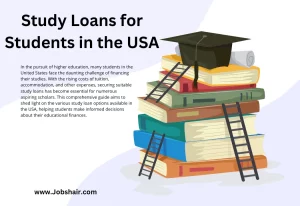Introduction
In the pursuit of higher education, many students in the United States face the daunting challenge of financing their studies. With the rising costs of tuition, accommodation, and other expenses, securing suitable study loans has become essential for numerous aspiring scholars. This comprehensive guide aims to shed light on the various study loan options available in the USA, helping students make informed decisions about their educational finances.

Federal Student Loans
Federal student loans are a primary source of financial aid for American students. These loans, backed by the government, come with fixed interest rates and flexible repayment plans. There are several types of federal loans, including Direct Subsidized Loans, Direct Unsubsidized Loans, and Direct PLUS Loans. Eligibility for federal loans is determined based on financial need, and the application process involves completing the Free Application for Federal Student Aid (FAFSA).
Private Student Loans
In addition to federal aid, students can also opt for private student loans offered by banks, credit unions, and other financial institutions. Unlike federal loans, private loans have varying interest rates and repayment terms, often depending on the borrower’s credit history and income. While private loans may provide more flexibility in terms of borrowing limits, they lack the benefits and protections offered by federal programs.
Interest Rates and Repayment Options
Interest rates on student loans can significantly impact the overall cost of education. Federal loan interest rates are set by Congress and typically lower than those of private lenders. Repayment options for federal loans include standard, income-driven, and extended plans, allowing borrowers to choose a plan that suits their financial circumstances. Private lenders offer similar repayment options but may not provide the same level of flexibility or borrower protections.
Scholarships and Grants
Scholarships and grants are valuable resources for reducing the need for student loans. Unlike loans, scholarships and grants do not require repayment and are awarded based on various criteria, including academic achievement, financial need, and extracurricular involvement. Students can explore scholarship opportunities through their schools, community organizations, and online databases to offset tuition costs and minimize reliance on loans.
Loan Forgiveness and Repayment Assistance Programs
For graduates burdened with student loan debt, there are options for loan forgiveness and repayment assistance. Public Service Loan Forgiveness (PSLF) and Teacher Loan Forgiveness are federal programs designed to forgive a portion of student debt for individuals working in certain public service professions. Additionally, some employers offer student loan repayment assistance as part of their employee benefits package.
Managing Student Debt
Effective debt management is essential for avoiding financial hardship after graduation. Students can mitigate the impact of student loans by creating a budget, prioritizing loan payments, and exploring options for loan consolidation or refinancing. Seeking guidance from financial advisors or student loan counselors can provide valuable insights into managing debt responsibly and avoiding default.
Impact of Student Loans on Credit
Student loans can have a significant impact on borrowers’ credit scores. Timely repayment of loans demonstrates financial responsibility and can positively affect credit history. Conversely, defaulting on loans or missing payments can damage credit scores and hinder future financial opportunities, such as obtaining mortgages or car loans. It is crucial for students to prioritize loan repayment and maintain good credit habits.

Resources for Loan Assistance
Numerous resources are available to assist students in navigating the complexities of student loans. Websites such as StudentLoans.gov and Federal Student Aid offer comprehensive information about federal loan programs and repayment options. Additionally, student loan counseling services and financial literacy programs provide personalized guidance to help borrowers make informed decisions about their finances.
Future Outlook
The landscape of student loans and educational financing is constantly evolving. As policymakers and stakeholders continue to address issues of affordability and access to higher education, changes in loan policies and regulations may occur. It is essential for students to stay informed about developments in student loan programs and explore all available options for financing their education.
Conclusion
Navigating the world of student loans can be challenging, but with careful research and planning, students can find suitable financing options for their educational goals. Whether opting for federal loans, private loans, or seeking alternative forms of financial aid, it is crucial to consider the long-term implications of borrowing and prioritize responsible financial management.
FAQs
- How do I determine if I qualify for federal student loans? To qualify for federal student loans, you must complete the Free Application for Federal Student Aid (FAFSA) and meet eligibility criteria based on financial need.
- Can international students apply for study loans in the USA? International students may have limited options for study loans in the USA, but some private lenders offer loans with a U.S. cosigner.
- What are the main differences between federal and private student loans? Federal loans are backed by the government and offer fixed interest rates and flexible repayment options, while private loans are offered by banks and have varying terms based on creditworthiness.
- Is it possible to refinance student loans for better terms? Yes, borrowers can refinance student loans through private lenders to potentially lower interest rates or adjust repayment terms.
- How do I avoid defaulting on student loans? To avoid defaulting on student loans, maintain regular payments, explore repayment assistance programs, and seek guidance from financial advisors if experiencing financial hardship.